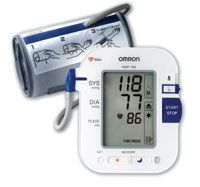Publication
Article
Pharmacy Times
OTC Product News: Profile: A Closer Look at New FDA Actions: Omron HEM-780
Author(s):
Dr. Holmberg is a freelance clinicalwriter based in Phoenix, Arizona.
Using GoodTechnique for HomeBlood PressureMonitoring
In order to obtain an accuratehome blood pressurereading, it is important thatthe patient follows good technique.The AHA recommendsthe following:
? Choose a cuff that fits properlyaround the upper arm
? Avoid nicotine, caffeine,or exercise for 30 minutesprior to the blood pressurereading
? Sit with a straight and supportedback
? Keep both feet flat on thefloor
? Place the middle of the cuffdirectly over the brachialartery. Rest the arm on aflat surface, such as a tableor countertop, which allowsthe upper arm to be atheart level.
? Take 2 or 3 readings, eacha minute apart, and recordeach value
? Obtain readings at consistenttimes throughouttheday as directed by a healthcare professional. Forexample, some professionalsmay wish to see morningand evening readings toassess blood pressure controlthroughout the day.
Per the Seventh Report of the JointNational Committee on Prevention, Detection,Evaluation, and Treatment ofHigh Blood Pressure (JNC 7), hypertensionis defined as blood pressure of≥140/90 mm Hg (130/80 mm Hg forpatients with diabetes). Treatment withantihypertensive medications has beenassociated with a decrease in the incidenceof complications from hypertension,such as stroke, myocardial infarction,and heart failure.1
Often called the "silent killer," hypertensionmay not have any symptoms,and when uncontrolled, it can lead toorgan and blood vessel damage, especiallyin the kidneys and heart. An estimated1 in 3 American adults has hypertension—and may not even know it.2
Time of day may influence blood pressurecontrolgoals and the potential forhypertension-relatedmorbidity. Patients experiencingmorninghypertension—a weeklyaverage blood pressurereading of over 135/85mm Hg within 1 to 2hours of awakening inthe morning—may beat an increased risk forstroke, organ damage,and other cardiovascularevents. Identifying morninghypertension maybe challenging, as oftenthe rise in blood pressuremay have subsided bythe time the patient presentsto their medical provider.
Home monitoringcan help to track earlymorningtrends, thus recognizingmorning hypertensionand optimizingits treatment.3
Home BloodPressure Monitoring:Omron HEM-780

The Omron HEM-780 automaticblood pressuremonitor offers an accurateand easy way forpatients to monitor theirblood pressure readingsat any time of day.This monitor is the firstand only blood pressuremonitor designed to detectmorning hypertension.4 The machine automaticallyaverages the morning readingsfor each user and displays an alert if theweekly average is above 135/85 mmHg.5
In addition to the morning hypertensionalert, the HEM-780 is able to detectany irregularities in the heartbeat. It alsooffers a hypertensionindicator and can store200 values with a timeand date stamp for upto 2 different individualsand a guest.
The HEM-780 offersthe 1-touch automaticoperation.It also featuresthe IntelliSense system,which inflates the cuff toits ideal level each timethe monitor is used, withoutrequiring the patientto specify an inflationlevelprior to each use.This allows a quicker andmore comfortable readingfor the patient. Theproduct's ComFit Cuff isa patented preformedcuff promoted to providea comfortable, easy fit formedium or large arms.The TruRead mode takes3 consecutive measurements,each 1 minuteapart, as recommendedby the American HeartAssociation (AHA), anddisplays the average ofthe 3 values.4
The HEM-780 has beentested per the protocolsof the Association for theAdvancement of MedicalInstruments (AAMI) andthe European Societyof Hypertension.4 TheAHA recommends thatpatients choose a monitorthat has been approved, tested,and validated by the AAMI, the BritishHypertension Society, or the InternationalProtocol for the Validation of AutomatedBlood Pressure Measuring Devices.6
References
- JNC 7 Express The Seventh Report of the Joint National Committee on Prevention, Detection, Evaluation, and Treatment of High Blood Pressure. US Department of Health and Human Services, National Institutes of Health, National Heart, Lung, and Blood Institute Web site. www.nhlbi.nih.gov/guidelines/hypertension/express.pdf. Accessed August 2008.
- What is high blood pressure? National Heart, Lung, and Blood Institute Web site. www.nhlbi.nih.gov/health/dci/Diseases/Hbp/HBP_WhatIs.html. Accessed August 2008.
- What is morning hypertension and how do I know I have it? Omron Healthcare Inc Web site. www.omronhealthcare.com/article/detail.asp?c=238. Accessed August 2008.
- HEM-780 Product Information. Omron Healthcare Inc Web site. www.omronhealthcare.com/product/detail.asp?p=1117&t=186. Accessed August 2008.
- Dangerous Condition Underscores Importance of Home Blood Pressure Monitoring. Omron Healthcare Web site. www.omronhealthcare.com/news/detail.asp?c=255. Accessed August 2008.
- Home monitoring of high blood pressure. American Heart Association Web site. www.americanheart.org/presenter.jhtml?identifier=576. Accessed August 2008.







